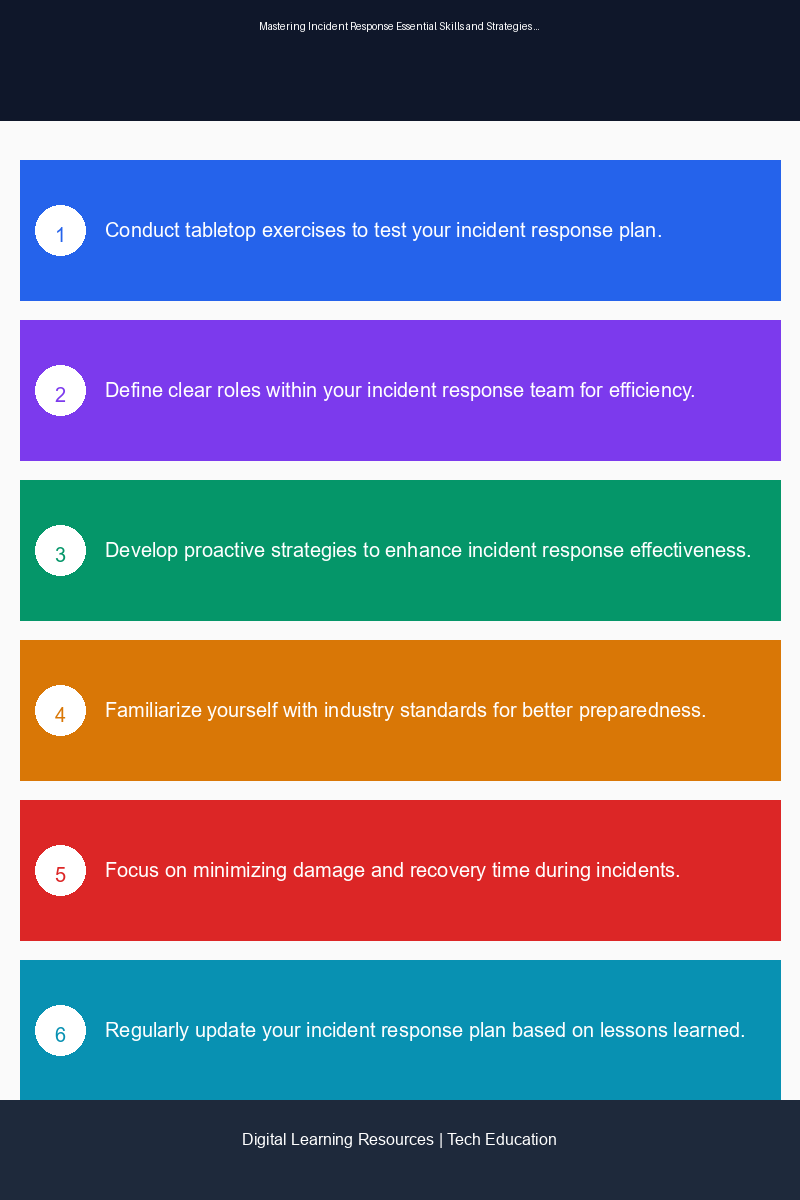In today’s digital landscape, the threat of cyber attacks looms large over organizations of all sizes. An effective incident response strategy is crucial not only for immediate damage control but also for long-term business continuity. In this comprehensive guide, we will explore the technical concepts behind incident response, practical applications, and the skills you need to excel in this field. Whether you’re a developer, IT professional, or tech learner, this post will provide actionable insights to enhance your career and readiness against cyber threats.
Key Takeaways
- Incident response is a strategic approach to managing cyber attacks.
- Tabletop exercises are essential for testing incident response plans.
- Understanding roles and responsibilities within an incident response team is vital.
- Proactive incident response strategies are increasingly recognized as essential.
- Engaging with industry standards can enhance your incident response capabilities.
Technical Background and Context
Incident response (IR) refers to the approach organizations take to prepare for, detect, mitigate, and recover from cyber incidents. At its core, IR is not just about fixing problems; it’s a strategic framework aimed at minimizing damage and reducing recovery time and costs. A comprehensive incident response plan is essential for business continuity and disaster recovery, ensuring that a company can withstand unexpected cyber threats.
One of the most effective tools for refining your incident response capabilities is the incident response tabletop exercise. These exercises are designed to test the processes outlined in an incident response plan through realistic, discussion-based scenarios. They can be tailored to reflect the specific threat landscape of an organization, ensuring that the team is prepared for the challenges they may face.
📚 Recommended Digital Learning Resources
Take your skills to the next level with these curated digital products:
AI Enhanced Resume Builder
AI Resume Builder Flask App – Complete Source Code + PDF Tutorial + HTML | Digital Download for Designers
Learn AWS: Your First Cloud Application
Learn AWS: Your First Cloud Application
📊 Key Learning Points Infographic

Visual summary of key concepts and actionable insights
Comprehensive SAT Prep: 470+ Vocabulary Words
Comprehensive SAT Prep: 470+ Vocabulary Words
Master DevOps in Practice – 50 Essential Topics for Engineers (PDF eBook)
Master DevOps in Practice – 50 Essential Topics for Engineers (PDF eBook)
The Ultimate Keyboard Shortcut Guide 49 Software Cheat Sheets in One PDF Bundle
The Ultimate Keyboard Shortcut Guide 49 Software Cheat Sheets in One PDF Bundle
Practical Applications and Use Cases
To effectively implement an incident response plan and conduct tabletop exercises, consider the following practical applications:
- Incident Response Team Roles: Every member of the incident response team should understand their responsibilities, from the incident commander to the communication lead. Clear role definitions streamline incident management.
- Realistic Scenarios: Tailor scenarios to reflect actual threats your organization faces. For example, if your organization is frequently targeted by phishing attacks, create a scenario based on that threat.
- Tool Utilization: Familiarize yourself with tools like antivirus software, intrusion detection systems, and logging tools. Knowing how to use these tools effectively can significantly enhance your response capabilities.
- Post-Exercise Reviews: After each tabletop exercise, conduct thorough debriefings to assess what went well and what needs improvement. This feedback loop is crucial for refining your incident response strategy.
Learning Path Recommendations
For tech professionals looking to deepen their understanding of incident response, consider the following learning paths:
- Foundational Knowledge: Start with courses that cover the basics of cybersecurity, focusing on common attack vectors and incident response methodologies.
- Specialized Training: Enroll in courses that focus on incident response planning and execution. Look for programs that include hands-on exercises.
- Tabletop Exercise Facilitation: Learn how to design and facilitate tabletop exercises. This skill is critical for testing the effectiveness of your incident response plan.
- Certifications: Consider certifications like Certified Incident Handler (GCIH) or Certified Information Systems Security Professional (CISSP) to validate your skills.
Industry Impact and Career Implications
The emphasis on proactive incident response strategies is growing across industries. Organizations are increasingly recognizing that effective incident response goes beyond merely having a plan; it involves ongoing training and realistic scenario practice. By engaging with industry standards set by organizations like NIST and the U.S. Department of Homeland Security, professionals can align their practices with the best in the field.
As a tech professional, mastering incident response can open doors to various career opportunities, such as:
- Incident Response Analyst
- Security Operations Center (SOC) Analyst
- Cybersecurity Consultant
- IT Risk and Compliance Manager
Implementation Tips and Best Practices
To effectively implement your incident response strategies, keep these best practices in mind:
- Establish Clear Communication: Ensure that communication channels are clear and accessible during an incident. This includes both internal communication and communication with external stakeholders.
- Regular Training: Schedule regular training sessions and tabletop exercises to keep the team sharp and ready to respond.
- Documentation: Keep detailed records of incidents, responses, and lessons learned. This documentation can be invaluable for future training and audits.
- Continuous Improvement: Treat incident response as an evolving process. Regularly update your plans and training materials based on new threats and organizational changes.
Future Trends and Skill Requirements
As the cybersecurity landscape continues to evolve, professionals in incident response must stay ahead of the curve. Here are some trends and skills that will become increasingly important:
- Automation in Incident Response: Familiarity with automation tools can enhance response times and accuracy.
- Threat Intelligence Integration: Understanding how to integrate threat intelligence into your incident response plan will provide a more proactive approach to potential incidents.
- Cloud Security Awareness: With the rise of cloud computing, understanding cloud-specific vulnerabilities and response strategies will be crucial.
Conclusion with Actionable Next Steps
Incident response is a critical component of any cybersecurity strategy, and developing expertise in this area can significantly impact your career. Start by familiarizing yourself with the concepts discussed in this guide, and consider enrolling in relevant training courses to build your skills.
Take the following actionable steps:
- Assess your current understanding of incident response and identify areas for improvement.
- Engage with your organization to participate in or facilitate tabletop exercises.
- Stay informed about industry trends and integrate these insights into your incident response planning.
- Explore certifications that will bolster your credibility in the field.
By investing time and effort into mastering incident response, you will not only enhance your professional skill set but also contribute to a more secure digital environment.
Disclaimer: The information in this article has been gathered from various reputed sources in the public domain. While we strive for accuracy, readers are advised to verify information independently and consult with professionals for specific technical implementations.
Ready to advance your tech career? Explore our digital learning resources including programming guides, certification prep materials, and productivity tools designed by industry experts.



